Digital Transformation is reinventing organisations using digital technology and we went to see how the travel industry could take the best practice from other sectors into making booking easier and customer service seamless.
The pace of change over the last 5 years has been hugely significant with businesses accelerating their digital capabilities at an astonishing rate. With this rapid transformation comes the need to properly harness digital technologies and put them into effective use.
This is what some of the speakers said.
Bruce Daisley – Building a culture of innovation –Twitter
First Bruce Daisley talked about how to build a culture of innovation within the workplace. He focused on two themes a business needs to establish a positive innovation culture.
- positive effect
“doctors that are in a state of positivity are more likely to collaborate and do a better job”. - psychological safety
“the willingness of people to speak up to managers and bosses if they think something is not right no matter what level you are at”.
The main theme of this talk was that by syncing, creating harmonious teams, we can build psychological safety, reduce stress, increase collaboration, harness ideas and increase performance levels by 23%.
I loved these points:
- Reduce unnecessary meetings, meetings, meetings… “Employees spend an average of 1.2 hours every single working day in meetings, equalling six hours every week”. Personnel Today
- The power of walking – send people out for a walk together and increase new ideas by two thirds. As the philosopher Friedrich Nietzsche wrote in 1889, “All truly great thoughts are conceived by walking”.
- Crisp Thursdays, Wednesday Chinwag, Friday Fry up – it doesn’t matter what you call it, create a reason to sync your teams for a catch-up. Teams who prioritise syncing outperform other companies.
Find out more:
- Listen to the Eat, sleep, work, repeat podcast https://eatsleepworkrepeat.fm/podcast/
- Read the book “The Joy of Work: 30 Ways to Fix Your Work Culture and Fall in Love with Your Job Again” https://eatsleepworkrepeat.fm/book/
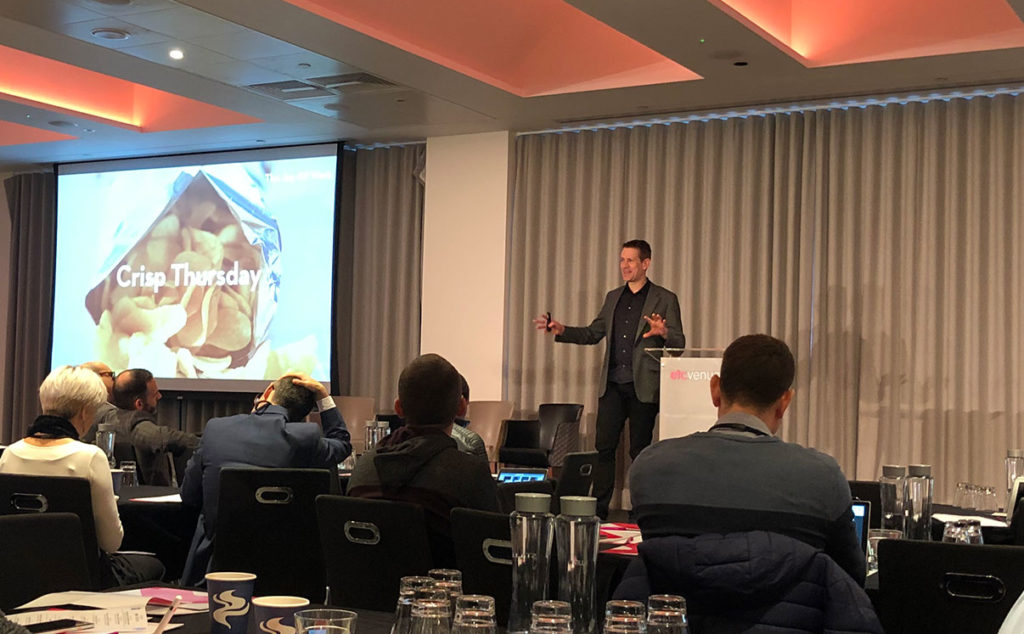
Aaron Holt – Are you on the right side of disruption? – Pluralsight
Second on the stage was Aaron Holt. He gave some excellent pointers on how to acquire, develop and retain skills, using the team you have in order to cause digital disruption.
What is Digital Disruption?
“Digital disruption is the change that occurs when new digital technologies and business models affect the value proposition of existing goods and services.” SearchCIO.
I picked up these key takeaways:
- Do you know what skills you have within your organisation to tackle digital disruption?
- Have you identified the skills you need to build in your organisation, so you don’t become the next company going into administration?
- Retention is a problem, especially with millennial’s. They don’t feel invested in and they want to professional development. They want to work on sexy projects and emerging technologies.
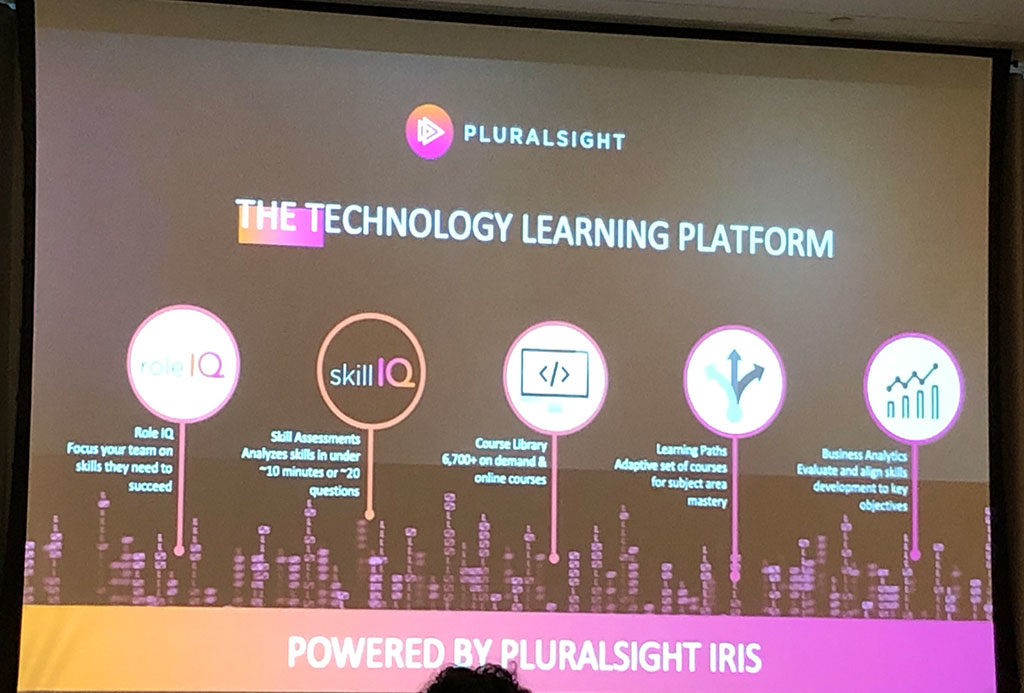
Hayley Cochrane – The Art & Science of Loyalty – Mail Online
Up next, Hayley Cochrane started her talk by asking us a question. Was Leonardo Da Vinci an artist or a scientist?
“Da Vinci may be best known for his artistic masterpieces, but he was also an accomplished engineer and scientist, filling over 7,000 pages of notebook entries with his observations.” sciencefriday.com
The key meaning from this talk is that we don’t have to be one dimensional, art informs science and science informs art. Art and science gives you loyalty. But just like Da Vinci, you can use art and science to develop your own loyalty.
My take from her talk was:
- Never follow the same rules as your competitors – do it differently, be unique, create your own content with your own voice and identity
- Loyalty = daily habit + consistency + frequency (this is what every publisher aspires to).
- Art = Creativity + Intuition + Tone of Voice + Visual + Emotion. (This is what we should be aiming for with all our work
- Modern-day publishers are transforming from being story tellers to being multi-faceted, translating real-time analytics data into valuable insights that mean something to the reader, steer decisions and engage with readers
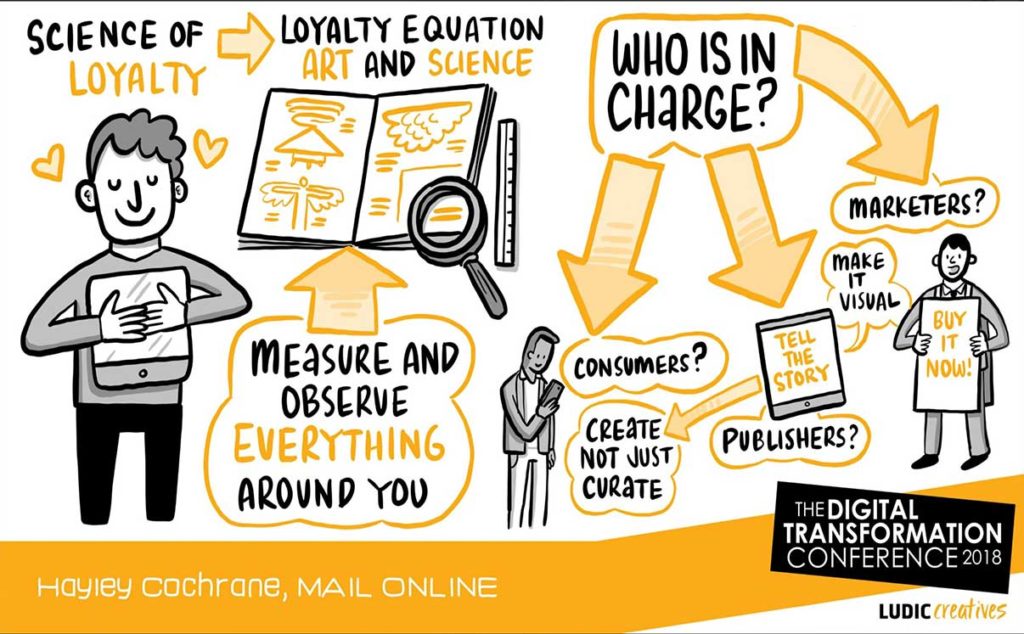
Yad Jaura – Leaving your legacy behind – LANSA
Yad Jaura kicked off by telling us that the need for digital transformation is piling on the pressure to deliver and to change the market we work in. Systems need to change and applications need to reach places that they haven’t before. The critical element in all this is the speed at which change takes place. Companies need to deliver transformation as quickly as possible to be in a market leading position as the industry is evolving rapidly.
Yad went through examples of businesses that have embraced digital transformation. Here’s one of them:
BCA Automotive – Car transportation company transformation project
- Used outdated systems which were more than 25 years old
- Redesigned their systems to make them fit for the future
- Used LANSA’s low-code development platform to build new apps 3x – 10x faster than traditional methods
- Allowed the move to mobile and web
- Brought IT closer to the business
As a result:
- BCA move more than 2 million cars through this system
- Allocators can build loads in real-time and deliver 97% load efficiency
- Profits have been significantly increased
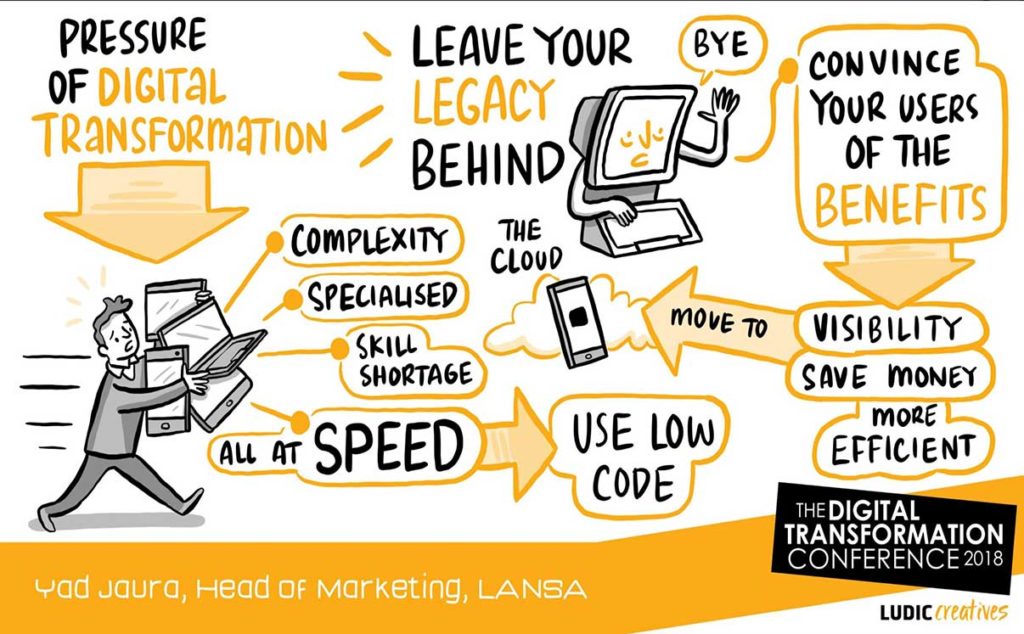
Clive Gardiner – Digital transformation is a risky business – NSPCC
Clive started his talk by telling us a little about the #NSPCC, and for those of you who don’t know what they do, here’s a link https://www.nspcc.org.uk/what-we-do/what-we-stand-for/
In the charities sector, the NSPCC have a large marketing team with about forty people working across digital engagement, production and development (content), intranet and data & analytics.
The NSPCC embraced digital transformation as they needed to change their emotional language to cut through.
ChildLine a core part of the NSPCC is still going strong, but now 80% of children are using messenger services and SMS from rather than calling.
The ChildLine app “For Me” was a user-led innovation giving the option for someone to have access to the ChildLine service in their pockets. Kids can download it for free. It was a complex build as it had to align into services such as counselling.
The NSPCC really had to assess the risk of developing and assess what is missing. They identified that pace was missing. Once they focused on pace, they came up with a list of things that moved the discussion forward, then started to get buy in.
My key takeaways:
- Take best practice from all competitors, not just charities
- Define the risks associated with not transforming quickly enough for users
- Evolve and build a common foundation of team skills and widen other areas for all teams rather than keeping skills to one central specialist
- Invest in digital marketing training. The NSPCC bought the fast track to digital marketing 12 modules for all the team. 81 people are on it already and 20 staff have completed
- Share what you’ve learning to help others in the sector and internally within teams
It is great to see that charities embracing emerging technology, innovating how they work and creating new digital experiences for the people they help.

Tim Walwyn – Elevating the digital workplace – Live Tiles
Last in the session before the coffee break was Tim from Live Tiles who’s talk focused on finding and using software to empower users.
He asked us to think about:
- How do we evolve things faster in the workplace?
- How do we create something that is constantly evolving?
- How do we become sympathetic to other dependencies?
I liked this:
- Move from surviving to thriving
- Look for initiatives that compliment and accelerate the wider transformation
- Don’t be afraid of “point solutions” – solving one problem without regard to related issues Point solutions are widely used to fix a problem or implement a new service quickly
- Don’t stop transforming
- Iterate and improve
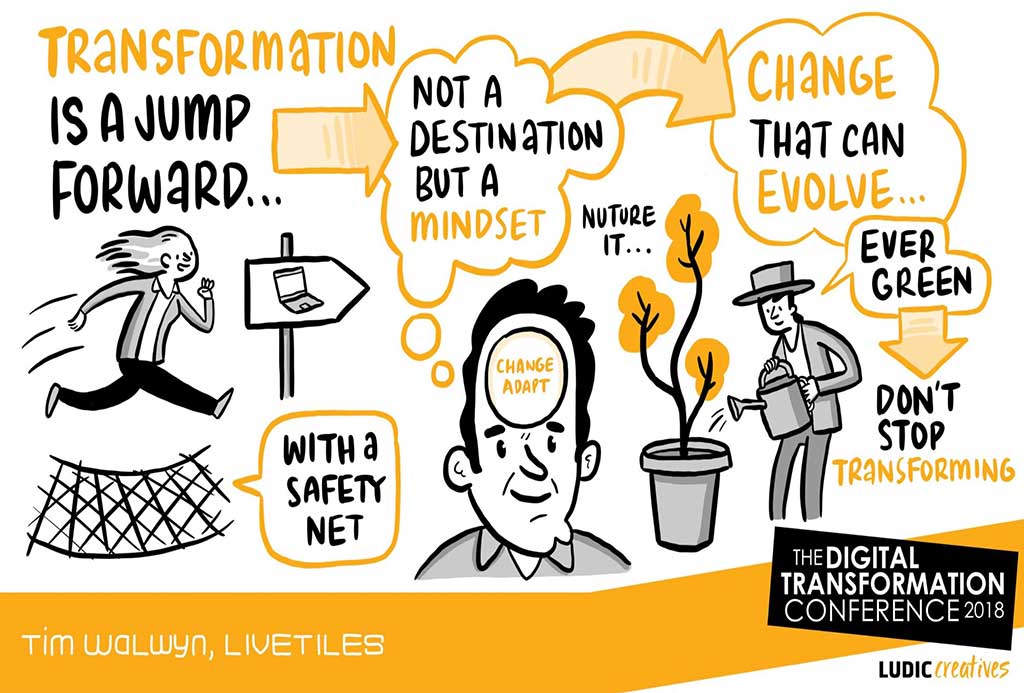
Richard Holden – How the Economist is changing the way it builds digital products – The Economist
After the break with plenty of caffeine and biscuits, we attended the topic of how to learn to build digital products with Richard Holden.
Richard led the talk by pointing out some painful things most project managers experience: lack of focus, changing goals, being distracted by other more exciting things.
When these things happen mid project, Richard told us to:
- take step back
- think about what your mission is
- start thinking more about the pain points for your users, not just doing things because they are new and shiny
The way forward:
Focus on solving customer problems. Digital is a means to an end – that end being better customer experience across all channels.
Don’t let the scope creep in, focus on the original brief, don’t get sucked into making loads of changes, stick to what you believe.
Richard then went on to explain this process below, which the Economist followed when developing a new app nicknamed Lamarr. They did this, rather than updating the existing app, in order to answer users’ problems.
- Ran a series of problem finding interviews with actual customers to identify problems with their current app.
- After identifying the problems, they created a hypothesis about what people wanted.
- Started sketching prototypes to make the best experience possible.
- Test prototypes with subscribers, beta versions, alpha test with readers using the app in real life, videoing themselves using it.
- Test and learn, before putting it live, evolve the product over time.
- Prepare to be wrong: time stamps confused readers, readers preferred editorial curation not algorithms or personalisation, section prioritisation feature was less popular than expected (it broke the users’ mental code)
- Learn to develop a thick skin, it’s not for everyone. There will always be people that complain.
- Develop a North Star Metricto quickly understand what works and align better with commercial. “The North Star Metric is the single metric that best captures the core value that your product delivers to customers. Optimising your efforts to grow this metric is key to driving sustainable growth across your full customer base.” growthhackers.com
- Apply this methodology to other developments / products.
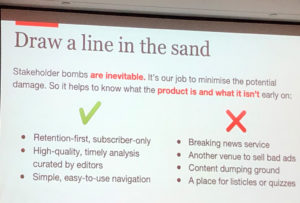
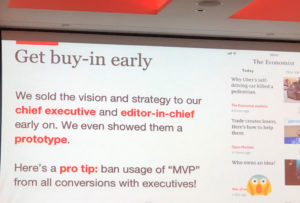
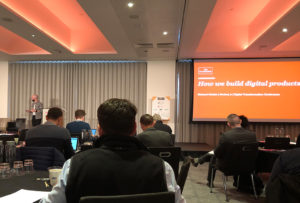
Iain Sawbridge – Powering a Transformation – Beano Studios
The Beano comic, for those that remember it, is still in circulation and is the longest running British children’s comic magazine. The Beano comic has enjoyed 80 years of breaking the rules – they still print the comic on a weekly basis.
Beano Studios is a 2 ½ year-old start-up that is in the market of understanding kids. They’ve learned a thing or two about kids, what they like, dislike, how they interact with digital. It’s a global content business powered by today’s kids.
Here are a few things to remember:
- Kids are not fond of rules
- Kids will build better things
- Kids have no respect for the status quo
- Kids change things
- Kids push the human race forward
- Kids are spending an unbelievable amount of time online
The Beano global content platform:
- 250 + characters
- Ripe for reinvention
- Live action animation
- Digital entertainment network – it’s like a ‘buzz feed’ for kids. It’s a safe platform for kids.
- A new TV show was inspired by the platform
- 500K + monthly unique visits
- Over 3.5 million kids on beano.com
Think More Kid:
- Kids are using AI – “Alexa: open beano”
- Kids really know what they’re doing digitally – and under the minimum age of Instagram which is currently 13. They are digital masters. They have more than one Instagram account and they know what click bait is.
- Kids are really engaged in world happenings.
- All kids will give us their age, but 27% of kids will not give us their gender – they don’t see it as important.
- Kids build their own identities online.
- Kids want information on HMFI – help me fit in.
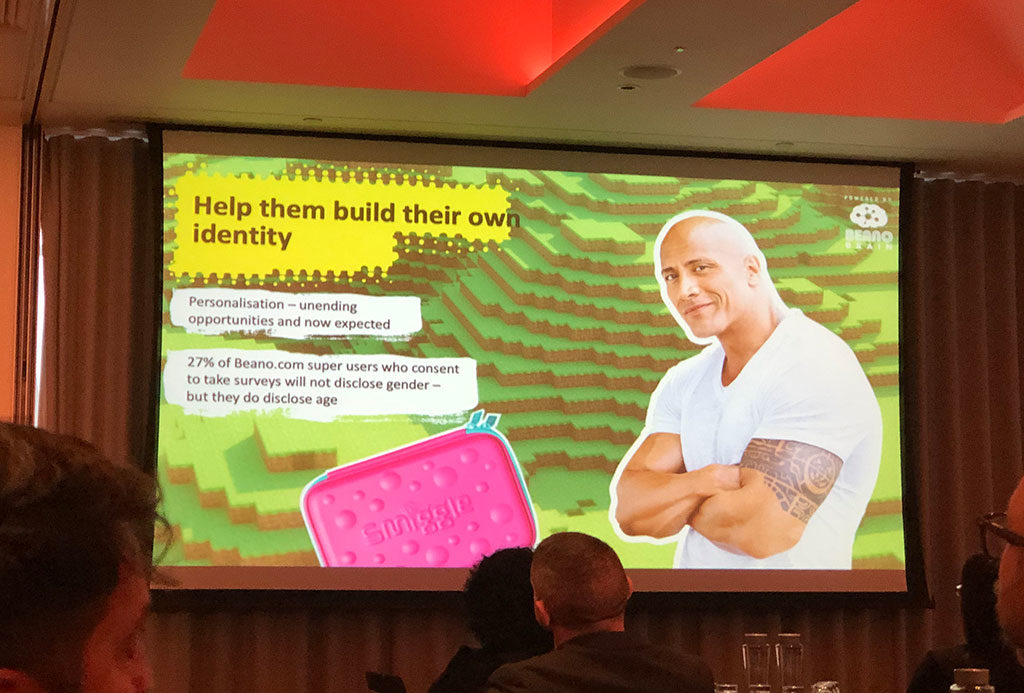
Key takeaways:
- Encourage creativity
Kids make their own videos, they’re selling stuff on snap-chat…
- Kids are really cautious digitally
They don’t explore, they navigate safely and don’t like clutter.
- Supercharge kid power
They will teach their parents a thing or two. Kids know more about plastics than their parents.
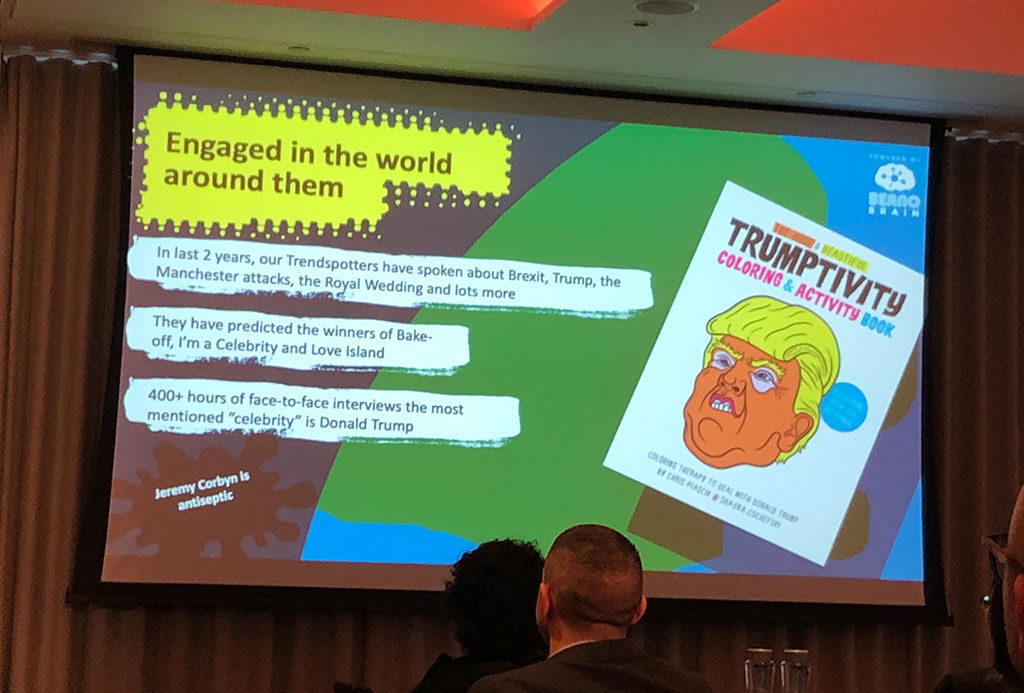
Question time:
Why do kids love quizzes?
The desire to master things, they love getting better at stuff. They don’t have low attention, they are just really picky about what they like and once they like it, they go deep, deep, deep. They are exploring who they are and how they fit in the world.
How do you address the fact that kids get older and change? How do you adapt and manage churn?
Good question, the obvious answer is that we talk to our kids all the time and get their new opinions. Hopefully if we stay on point and keep talking to kids, we should be able to stay relevant.
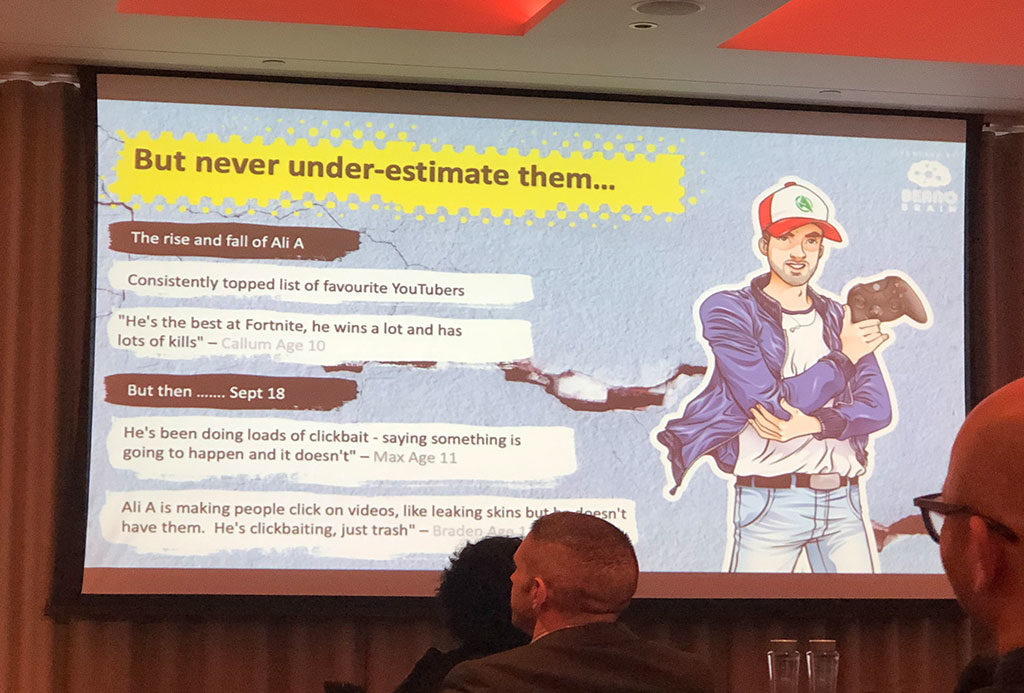
Jason Arundel – Engaging Digital Natives – M-Files
Jason starting out by asking the question that is on everyone’s mind – “Who is your target audience and what technology are they using”?
Everyone’s buying and ordering things via some form of technology. They are ordering their food via apps, buying their festival tickets online and saving the ticket on their wallet on their phones.
Think about the next generation. Kids’ perception of technology is very different to ours. Kids have a baseline expectation of touchscreens.
Are we thinking about the next generation in the workplace?
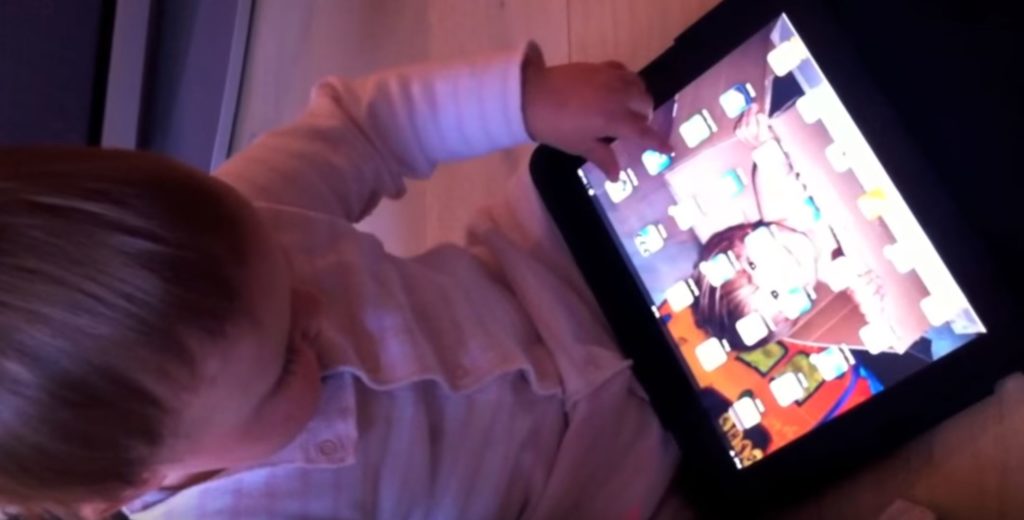
Key takeaways:
- Is your organisation in content chaos?
52% of organisations use four or more content systems, 62% are completely reliant on network share files. And what about mobility? Do away with long convoluted folder structures and tag files with easily understandable descriptions such as tag: proposal, client name, etc, so users can find it easily. Apply structure to unstructured data. It’s a far more intelligent way of working.
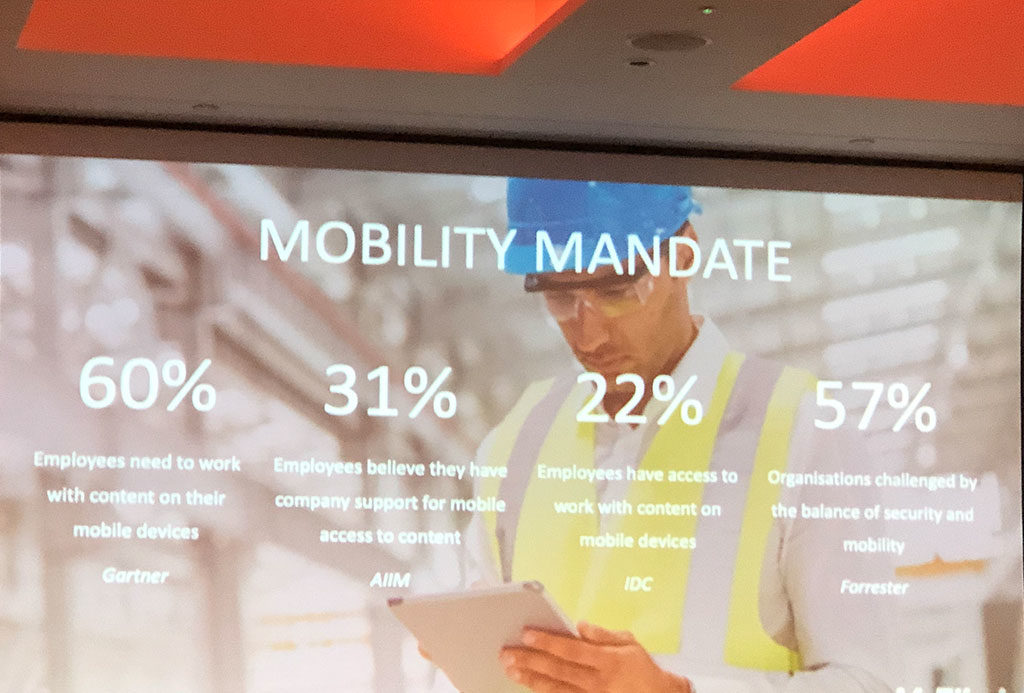
- Is your organisation in requirement chaos?
The key requirement is agility: we’ve got to think about delivery and agility. Develop a new architecture that allows people to access the digital workplace at any time, any place and on any device. Agility in Technology: Think about what you need to deliver to achieve a vision in small chunks, to easily move through the journey, making small changes and incorporating them easily. In partnership with that is technology. If the technology doesn’t allow you to be flexible (agile), then it will be difficult to deliver.
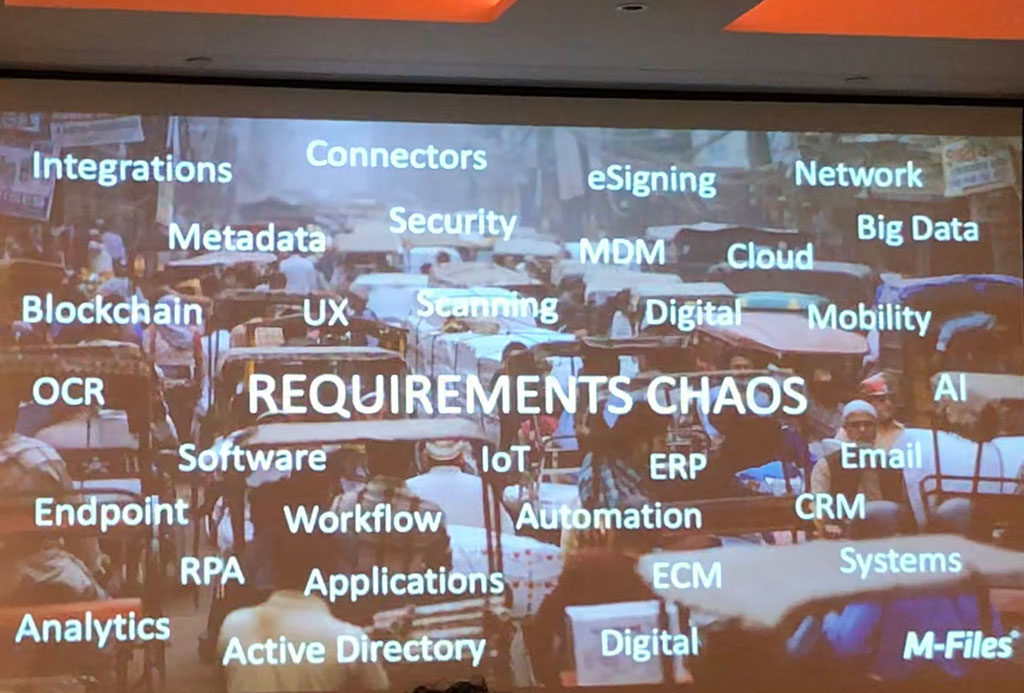
- Focus on the destination
Think about your vision … then manage your journey.
Panel session Q&A
The panel of five each gave their opinions and advice in answer to two key questions, firstly what is the key requirement for a superior digital workplace and secondly, what are the transformation trends for 2019, what’s next?
The Digital Workplace
- Be agile – create cross functional and smaller teams
- Move to a cloud-based strategy
- Email is dead – Millennial’s in the workplace expect chat-bots and messengers.
- Organisations are really struggling with flexible working, enable the ability to work from any location and implement the technology to do just that. This is what the millennial’s want. We need to be able to work at a global level.
- Talk face-to-face with people – if you’re working across different regions invest in good quality video conferencing technology.
Transformation Trends: What’s next, what’s coming?
- Jason Arundel said … Allowing the machine to take out the human administrative tasks so you can focus on the more exciting work.
- Lucia Adams said … Apply the humanity and collaborate more – meet the teams where they are and moving forward step-by-step that gets us to higher places.
- Jia Yan Gu said … We will see more automation and more data driven.
- Lucia Adams said … I predict digital transformation will die. The word digital is way overused already.
- Elizabeth O’Neill said … Chat bots is what I’m putting my money on.
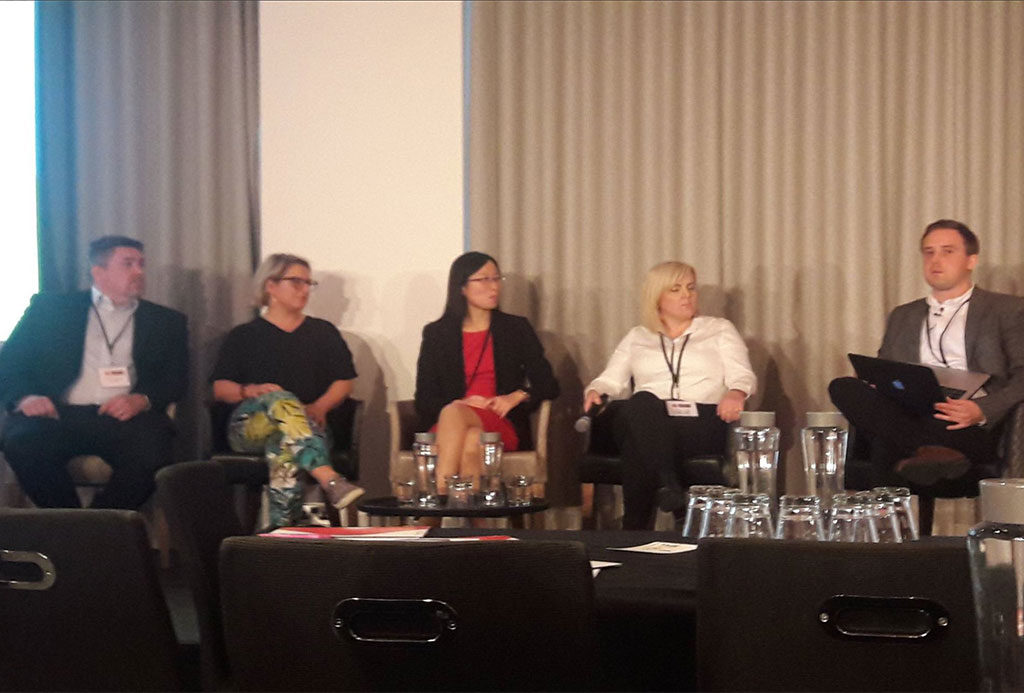
Bethany Gildersleve – Digital Technology Delivery & Execution – Sky Betting & Gaming
Bethany ran through a number of digital projects she has worked on during her career backed by her own opinions about the pros and cons of each which included Automating Post Office Branches, the NHS Choices Feedback Service, the NHS Apps Library and SkyBet’s Sportsbook Project.
Remember to:
- Keep sharing the vision
- Focus on the goal and outcomes
- Continued stakeholder engagement and collaboration
- Learn from mistakes
- Don’t forget the user
- Encourage continuous improvement / development
- Embedding delivery practices
- Communicate, communicate, communicate…
- Be tenacious…
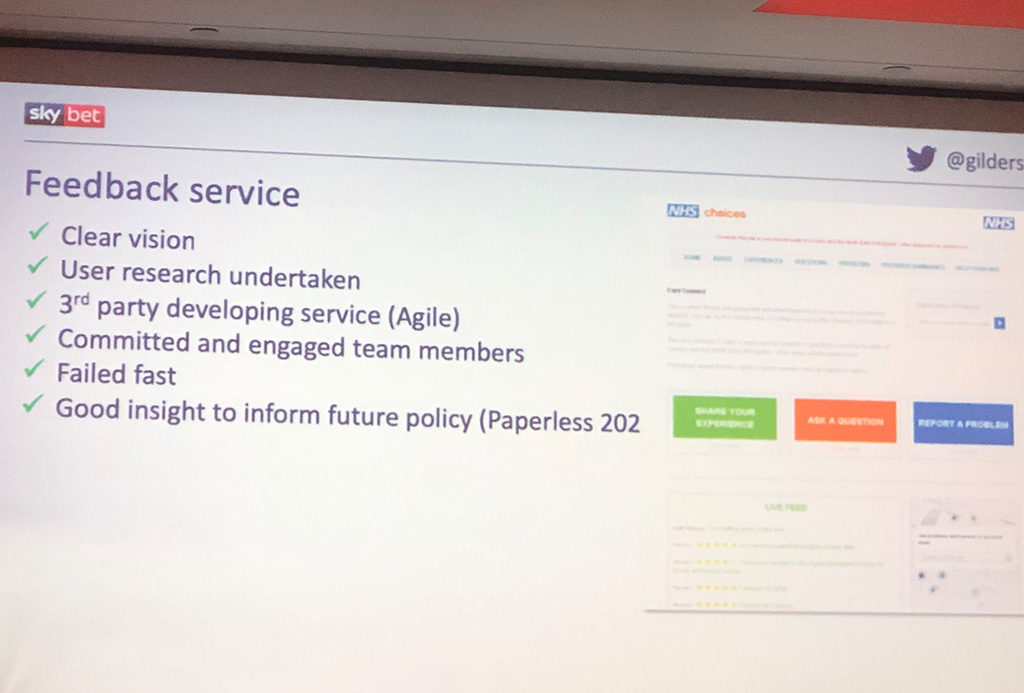
#DIGTRA returns to London May 2019, hope to see you there.